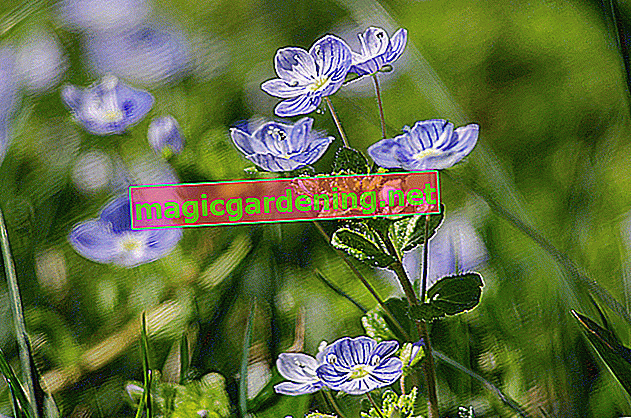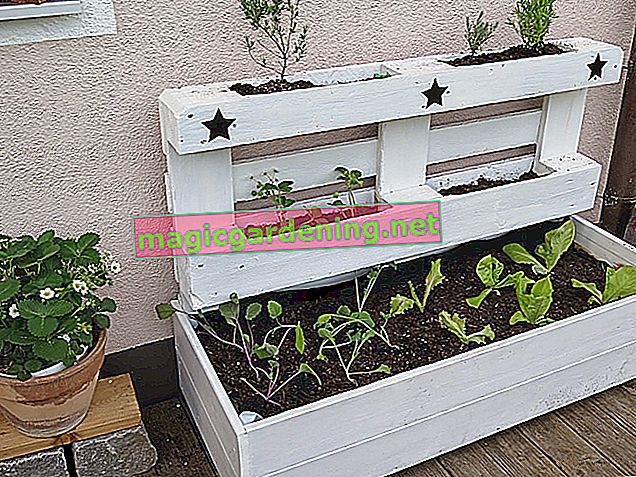
Plant speedwell properly
In order to live up to their status as shrub of the year, professional planting creates the best starting conditions. Both spring from mid-May and a mild day in September / October can be considered as the planting time. The still potted root ball is soaked in a vessel with water while you prepare the soil. If the flower demands nutrient-rich soil, add compost and horn shavings (€ 6.39 on Amazon *). For a rock garden plant, enrich the clod with a little sand and fine grit. After the preparation, proceed as follows:
- Dig a pit with 1-5 times the volume of the root ball
- Pot the plant and plant it in the optimized soil up to the lower pair of leaves
- Press the substrate on with your hands and pour
also read
- Earned speedwell in the garden - tips for proper care
- Popular garden shrub speedwell - a profile
- Native speedwell is hardy
If it is a perennial that grows as tall as a man, place a support post in the immediate vicinity and tie the plant with bast or special ties.
Care tips
If you assign Speedwell to a species-appropriate location, the maintenance program is limited to the following factors:
- The perennials water during summer drought
- Fertilize with compost and horn shavings at the beginning of the flowering period
- Cut off dead flowers for autumn re-bloom
- Wintergreen species are pruned close to the ground in spring
The frost-resistant plant does not require winter protection. You still wrap a bucket or flower box (€ 13.19 at Amazon *) thickly with bubble wrap and place the container on wood so that the root ball does not freeze through. Small pots are placed in frost-free winter quarters for safety.
Which location is suitable?
The Association of German Perennial Gardeners bows to the versatility of Ehrenpreis, in which the flower was named Perennial of the Year 2007. The plant expresses its virtuosity not least in terms of the divergent location requirements that its numerous species cover. A small selection from more than 450 species:
- Meadow speedwell: sunny location in a fresh, moist perennial bed, rich in nutrients and well-drained
- Stalked speedwell: sunny to partially shaded location in sandy-loamy to dry soil, rich in lime
- Candelabra-Speedwell: sunny to partially shaded place with moist soil without waterlogging
- Bachbunge: sunny to partially shaded locations with moist to wet soil with a slightly acidic component
The correct planting distance
Within the multi-faceted genus, specimens can be found with heights between a graceful 10 cm and a breathtaking 2 meters. For orientation, we have listed the most important data for the ideal planting distance below:
- Plant height 10-15 cm and width 20-30 cm corresponds to a planting distance of 30 cm
- Height of growth 20-30 cm and width 20-30 cm corresponds to a planting distance of 25 cm
- Height 50-80 cm and width 30-40 cm corresponds to a planting distance of 40 cm
- Plant height 90-140 cm and width 60-90 cm corresponds to a planting distance of 90 cm
The mighty candelabra-speedwell-varieties all clearly exceed the 1-meter mark and should be located in such a way that one specimen grows per square meter.
What soil does the plant need?
With regard to the nature of the soil, no universal statement can be made for the speedwell flower. Adjust the earth to your favorite perennial so that it can develop to its optimum. For example, a creek bungee in the rock garden floor will mourn sadly, while the moisture-loving plant thrives splendidly in the muddy bank area of your pond. A fresh, moist, nutrient-rich and humus-rich soil is required for the largest species, the candelabra-speedwell to develop its majestic stature.
What is the best time to plant?
Plant a pre-grown or pre-purchased speedwell perennial either in May or September. If you settle the flower in the garden by sowing, the appropriate time window is open in April and May. Alternatively, prefer the plant behind glass, which is possible from mid / late February when the light conditions on the windowsill improve.
When is the flowering time?
From spring to the first frost, the tireless flower adorns the garden and the planter if you can achieve an adequate combination. With more than 450 types of speedwell and countless varieties, you can confidently draw on the full. Let the following suggestion let your ideas flow:
- Stalked speedwell: flowering time from April to August
- Meadow speedwell: flowering time from May to July and second flowering in September / October
- Long-leaved speedwell: flowering period from July to August and remounting until the first frost
Since the plant has a remontant property, you can extend the flowering period by weeks as you please. To do this, with the species suitable for this purpose, after the first flowering, cut the perennial back by a third to a hand's breadth above the ground.
Cut speedwell properly
Mostly, speedwell thrives as a remounting perennial. This property implies the ability to re-bloom by cutting off the flower pile by a third to a hand's breadth above the ground after the first round. If you want the flower to reproduce by self-sowing, some specimens should be excluded from pruning. The main pruning is given to the plant in early spring, shortly before the fresh shoot. Until then, numerous evergreen Veronica varieties will adorn the otherwise dreary garden
Pour honorary award
Water the perennial so that it never dries out. The location conditions determine the frequency. Check the moisture content of the soil every 2-3 days to decide on the water requirements for each flower individually. For a plant in a tub or balcony box, there is regularly an increased demand for water due to the tightly limited substrate volume.
Fertilize speedwell properly
In nutrient-rich soil, speedwell develops its magnificent habit with its long-lasting flowering on its own. If the soil does not meet the ideal conditions, the perennial will gladly accept an organic start-up fertilization at the beginning of the flowering period. Compost, leaf earth, guano, bark humus, horn shavings or plant manure are suitable. Avoid, however, the use of nitrogen-stressed complete fertilizer, as this promotes leaf growth at the expense of the flower flora.
Overwinter
As a native perennial, speedwell is completely hardy. With the onset of the frosty season, the above-ground parts of the plant die of deciduous species. An evergreen plant holds out until early spring, only then to collect its leaves. The fresh shoots sprout from the overwintered rhizome at the beginning of the vegetation period. Therefore, no special precautions need to be taken in the bed. In the pot and balcony box there is of course the risk that the root ball will freeze through. As a precaution, vessels with a diameter of less than 30 cm move to frost-free winter quarters.
Speedwell multiply
Although the plant propagates busily in the bed by means of runners and seeding, fans of honorary awards still keep an eye out for methods of controlled offspring. Do one of the following:
- Sow behind glass from mid-February
- Direct sowing in the bed in April and May
- Division of the rhizome in spring
- Head cuttings during the summer flowering period
If it is a runners-forming plant, separate strong root strands and divide them into 10-15 cm long segments. As long as a section has at least one bud, it transforms into an adult flower within a short time in suitable soil.
How do I transplant properly?
As an extremely long-lived perennial, speedwell requires only every 6 to 10 years after regeneration by means of division and transplanting. If the plant begins to shed gradually from the middle, you should take action in April. Dig up the entire rhizome and shake off the earth. Use a sharp knife or a spade to cut the plant into two or more segments. You cut out the withering areas completely to dispose of them. At the previous or new location, place the rejuvenated perennial in fresh soil while maintaining the previous planting depth.
Is Speedwell Poisonous?
A variety of opulent speedwell species are rich in valuable ingredients. Therefore, the herbaceous plant has played a role in folk medicine for generations. First and foremost, the essential oils help alleviate respiratory diseases. In addition, the tender leaves of speedwell (Veronica officinalis) and other species, similar to watercress, can be made into a delicious vegetable or fresh salad. There can be no question of toxicity in this perennial.
How can I effectively combat speedwell in the lawn?
Speedwell does not always generate enthusiasm when it spreads out in the garden. First and foremost, its sky-blue flowers are not welcome in the lawn. Since the perennial thrives much more frugally and undemanding than the noble lawn grasses, it wins the race for supremacy. As a result, the previously velvety green lawn is transformed into a holey patchwork quilt. It doesn't have to come to that. The following methods have worked well in controlling speedwell in turf:
- Mechanical control: scarifying regularly; Cut out individual copies
- Chemical control with Banvel M, Weedex or Hedomat
Do not mow the lawn deeper than 4 cm. In this way, the lawn grasses cast enough shade on the plant so that it is cut off from sunlight and photosynthesis comes to a standstill.
Nice varieties
- Blue John: Violet-blue meadow honorary award, which has convinced experts in recent sightings; Height 50-80 cm
- Georgian Blue: Stalked speedwell as a deep blue magnificent ground cover for the rock garden and the grave; Height 10-15 cm
- Bachbunge: Moisture-tolerant Bach flower, which stands out on the edge of the pond with blue flowers; Height 20-30 cm
- Pink Damask: Long-leaved speedwell as a premium variety with lilac or pink flower candles; Height 50-60 cm
- Heidekind: The perfect variety for the flower-strewn steppe and cottage garden with purple-pink ears, height 30 cm
- Silbersee: Silvery shimmering foliage underlines picturesque deep blue flower panicles on creeping shoots; Height 15-20 cm
- Apollo: Majestic speedwell whose flower candles consist of lavender blue star blossoms; Growth height 140 cm








